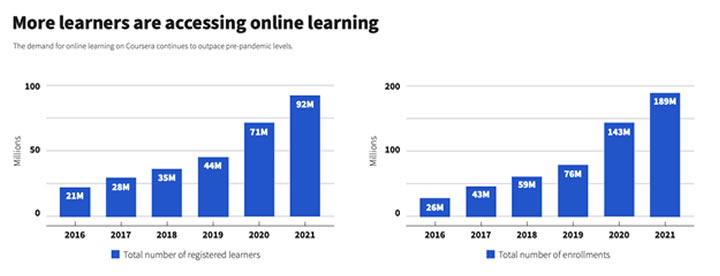Everyone that spends time on the internet must’ve heard of online learning, right?
Online learning is an education method where students learn in an entirely virtual environment. That said, students can have formal online education with the opportunity to get an online degree or learn new skills and get certificates for it.
With the accessibility to learn almost any subject tailored to your own schedule, online learning is getting quite popular these days.
Because of its popularity, there are many resources including online learning platform reviews and recommendations on the best online courses available. With all this, interest among aspiring students and professionals looking to improve themselves seems to be flourishing.
The first sights of online learning (also known as e-learning) appeared in 1960 with the PLATO platform that was invented by Donald Bitzer. This significant invention was really brilliant for its time.
But the “E-Learning” phrase was officially mentioned in 1999.
Online learning over the last decade
Before Massive Open Online Courses (MOOCs) online learning was mainly text-based content delivered via (new) technology.
In 2014, the Learning Management Systems (LMS) started using learning analytics to gather data on the students’ preferences regarding this education method.
The preferences were mainly learner’s choices and characteristics to better understand the student’s needs in the matter of course offering, interface, and instruction.
Now, let’s see how MOOCs changed the online learning industry for the better:
New opportunities for both instructors and students
With the free access to courses, MOOCs gave a new perspective and way of educational content creation and learning. More and more people were introduced to online learning and the possibilities that come with it.
The first bundle of MOOCs was produced by university professors
Coursera and edX introduced high-quality courses that people could access from their computers. These online courses were professionally created with videos, articles regarding the subject, clean interfaces, and media as a whole.
The concept was so attractive that many learning management systems adopted the MOOCs features.
Availability of online learning
MOOCs continue to provide online courses for everyone who is not able to access face-to-face education. This means that everyone who is willing to learn can start learning from wherever they are.
Finding out what works and what doesn’t in online learning
There were experimental studies on MOOCs and how people found their effectiveness.
With hundreds of thousands of online courses created, you can easily see what’s good and what works, and what doesn’t.
Here we can include many factors that give clarity to both instructors and students such as the popularity of subjects, ratings, and feedback, previews, prices, etc.
Online learning market growth
In 2017, the industry was worth $66 billion. After 5 years, the industry revenue is expected to increase by 126%, reaching $149 billion.
Top 5 leading countries in the online education market:
- US – $62 billion in revenue
- China – $47 billion in revenue
- UK – $8 billion in revenue
- India – $5 billion in revenue
- Canada – $4 billion in revenue
To showcase how important the market growth is, let’s take a look at one of the most popular online learning platforms – Coursera. They’ve published a report called the Coursera Impact Report that clearly illustrates the growing trends in the online learning industry.
According to the Coursera Impact Report, this online learning platform had 21 million registered students in 2016. This number was annually increasing by approximately 7 million for the next 3 years.
When the pandemic happened with the whole world switching to remote working the new registration figure rose to 71 million in 2020. In 2021, Coursera had more than 20 million new students registered.
By 2021, the single course enrollments peaked at 189+ million.
All these increases point to one thing – that online teaching and learning are globally accepted.

